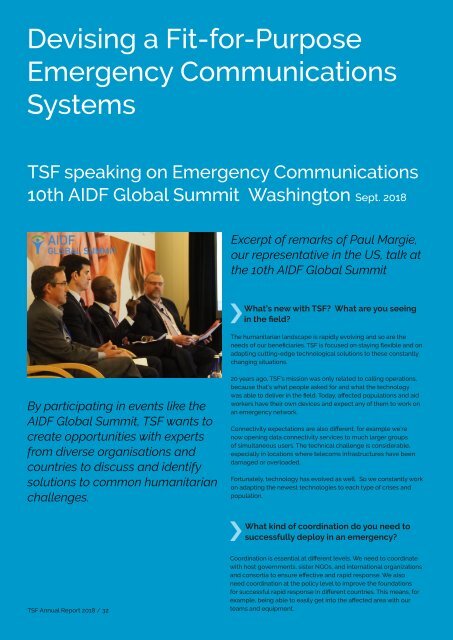Annual-Report-2018-test-Yumpu
You also want an ePaper? Increase the reach of your titles
YUMPU automatically turns print PDFs into web optimized ePapers that Google loves.
Devising a Fit-for-Purpose<br />
Emergency Communications<br />
Systems<br />
TSF speaking on Emergency Communications<br />
10th AIDF Global Summit Washington Sept. <strong>2018</strong><br />
Excerpt of remarks of Paul Margie,<br />
our representative in the US, talk at<br />
the 10th AIDF Global Summit<br />
What’s new with TSF? What are you seeing<br />
in the field?<br />
The humanitarian landscape is rapidly evolving and so are the<br />
needs of our beneficiaries. TSF is focused on staying flexible and on<br />
adapting cutting-edge technological solutions to these constantly<br />
changing situations.<br />
By participating in events like the<br />
AIDF Global Summit, TSF wants to<br />
create opportunities with experts<br />
from diverse organisations and<br />
countries to discuss and identify<br />
solutions to common humanitarian<br />
challenges.<br />
20 years ago, TSF’s mission was only related to calling operations,<br />
because that’s what people asked for and what the technology<br />
was able to deliver in the field. Today, affected populations and aid<br />
workers have their own devices and expect any of them to work on<br />
an emergency network.<br />
Connectivity expectations are also different, for example we’re<br />
now opening data connectivity services to much larger groups<br />
of simultaneous users. The technical challenge is considerable,<br />
especially in locations where telecoms infrastructures have been<br />
damaged or overloaded.<br />
Fortunately, technology has evolved as well. So we constantly work<br />
on adapting the newest technologies to each type of crises and<br />
population.<br />
What kind of coordination do you need to<br />
successfully deploy in an emergency?<br />
TSF <strong>Annual</strong> <strong>Report</strong> <strong>2018</strong> / 32<br />
Coordination is essential at different levels. We need to coordinate<br />
with host governments, sister NGOs, and international organizations<br />
and consortia to ensure effective and rapid response. We also<br />
need coordination at the policy level to improve the foundations<br />
for successful rapid response in different countries. This means, for<br />
example, being able to easily get into the affected area with our<br />
teams and equipment.


